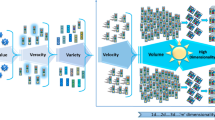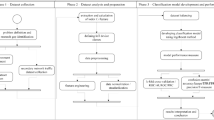Abstract
The present work introduces a hybrid integration of the self-organizing map and the hidden Markov model (HMM) for anomaly detection in 802.11 wireless networks. The self-organizing hidden Markov model map (SOHMMM) deals with the spatial connections of HMMs, along with the inherent temporal dependencies of data sequences. In essence, an HMM is associated with each neuron of the SOHMMM lattice. In this paper, the SOHMMM algorithm is employed for anomaly detection in 802.11 wireless access point usage data. Furthermore, we extend the SOHMMM online gradient descent unsupervised learning algorithm for multivariate Gaussian emissions. The experimental analysis uses two types of data: synthetic data to investigate the accuracy and convergence of the SOHMMM algorithm and wireless simulation data to verify the significance and efficiency of the algorithm in anomaly detection. The sensitivity and specificity of the SOHMMM algorithm in anomaly detection are compared to two other approaches, namely HMM initialized with universal background model (HMM-UBM) and SOHMMM with zero neighborhood (Z-SOHMMM). The results from the wireless simulation experiments show that SOHMMM outperformed the aforementioned approaches in all the presented anomalous scenarios.

















Similar content being viewed by others
Notes
In [7], only the discrete observation setting is addressed.
References
Allahdadi A, Morla R, Cardoso JS (2020) 802.11 wireless simulation and anomaly detection using HMM and UBM. SIMULATION 96(12):939–956
Allahdadi A, Morla R (2019) Anomaly detection and modeling in 802.11 wireless networks. J. Netw. Syst. Managem. 27(1):3–38
Allahdadi A, Morla R, Cardoso JS (2014) Outlier detection in 802.11 wireless access points using hidden Markov models. In: Wireless and Mobile Networking Conference (WMNC), 2014 7th IFIP. IEEE, pp 1–8
Somervuo P (2000) Competing hidden Markov models on the self-organizing map. In: Proceedings of the IEEE-INNS–ENNS international joint conference on neural networks, 2000. IJCNN 2000, vol 3. IEEE, pp 169–174
Kurimo M, Somervuo P (1996) Using the self-organizing map to speed up the probability density estimation for speech recognition with mixture density HMMs. In: Proceedings, fourth international conference on spoken language, 1996. ICSLP 96, vol 1. IEEE, pp 358–361
Morimoto H (2016) Hidden Markov models and self-organizing maps applied to stroke incidence. Open J Appl Sci 6(3):158–168
Ferles C, Stafylopatis A (2013) Self-organizing hidden Markov model map (SOHMMM). Neural Netw 48:133–147
Ferles C, Siolas G, Stafylopatis A (2013) Scaled self-organizing map-hidden Markov model architecture for biological sequence clustering. Appl Artif Intell 27(6):461–495
Lebbah M, Jaziri R, Bennani Y, Chenot JH (2015) Probabilistic self-organizing map for clustering and visualizing non-IID data. Int J Comput Intell Appl 14(02):1550007
Baldi P, Chauvin Y (1994) Smooth on-line learning algorithms for hidden Markov models. Neural Comput 6(2):307–318
Niina G, Dozono H (2012) The spherical hidden Markov self organizing map for learning time series data. In: International conference on artificial neural networks. Springer, pp 563–570
Yamaguchi N (2010) Self-organizing hidden Markov models. In: International conference on neural information processing. Springer, pp 454–461
Caridakis G, Karpouzis K, Drosopoulos A, Kollias S (2010) SOMM: Self organizing Markov map for gesture recognition. Pattern Recognition Letters 31(1):52–59
Jaziri R, Lebbah M, Bennani Y, Chenot JH (2011) SOS-HMM: self-organizing structure of hidden Markov model. In: International conference on artificial neural networks. Springer, pp 87–94
Ferles C, Beaufort WS, Ferle V (2017) Self-organizing hidden Markov model map (SOHMMM): biological sequence clustering and cluster visualization. Hidden Markov models. Springer, Berlin, pp 83–101
Ferles C, Stafylopatis A (2008) Sequence clustering with the self-organizing hidden Markov model map. In: 2008 8th IEEE international conference on bioinformatics and bioEngineering. IEEE, pp 1–7
Khreich W, Granger E, Miri A, Sabourin R (2012) A survey of techniques for incremental learning of HMM parameters. Inf Sci 197:105–130
Cho SB (2002) Incorporating soft computing techniques into a probabilistic intrusion detection system. IEEE Trans Syst Man Cybern Part C Appl Rev 32(2):154–160
Wang W, Guan X, Zhang X, Yang L (2006) Profiling program behavior for anomaly intrusion detection based on the transition and frequency property of computer audit data. Comput Secur 25(7):539–550
Rabiner L, Juang BH (1986) An introduction to hidden Markov models. IEEE ASSP Mag 3(1):4–16
Rabiner LR (1989) A tutorial on hidden Markov models and selected applications in speech recognition. Proc IEEE 77(2):257–286
Kohonen T (1982) Self-organized formation of topologically correct feature maps. Biol Cybern 43(1):59–69
Kohonen T (1993) Generalizations of the self-organizing map. In: Proceedings of 1993 international joint conference on neural networks, 1993. IJCNN’93-Nagoya, vol 1. IEEE, pp 457–462
Kohonen T (1995) Self-organizing maps. Springer, Heidelberg
Hammer B, Micheli A, Sperduti A, Strickert M (2004) A general framework for unsupervised processing of structured data. Neurocomputing 57:3–35
Juang BH, Rabiner LR (1985) A probabilistic distance measure for hidden Markov models. AT&T Tech J 64(2):391–408
OMNeT++ Discrete Event Simulator. https://www.omnetpp.org/. Accessed in July 2019
INET Framework. https://inet.omnetpp.org/. Accessed July 2019
Classification: ROC Curve and AUC. https://developers.google.com/machine-learning/crash-course/classification/roc-and-auc. Accessed May 2019
Fu B, Bernáth G, Steichen B, Weber S (2008) Wireless background noise in the Wi-Fi spectrum. In: 4th international conference on wireless communications, networking and mobile computing, 2008, WiCOM’08. IEEE, pp 1–7
Koski T (2001) Hidden Markov models for bioinformatics, vol 2. Springer, New York
Acknowledgements
This project was financed by the Portuguese funding agency, FCT—Fundação para a Ciência e a Tecnologia (Portuguese Foundation for Science and Technology), through national funds, and co-funded by the FEDER—Fundo Europeu De Desenvolvimento Regional (European Regional Development Fund), where applicable. The first author was sponsored by FCT grant SFRH/BD/99714/2014, and the second author was sponsored by FCT grant SFRH/BD/129600/2017.
Author information
Authors and Affiliations
Corresponding author
Ethics declarations
Conflicts of interest
The authors declare that they have no conflicts of interest.
Additional information
Publisher's Note
Springer Nature remains neutral with regard to jurisdictional claims in published maps and institutional affiliations.
Appendix
Appendix
According to the forward–backward algorithm, there are T ways to compute the likelihood value or probability of observation sequence O, given model \(\lambda \):
The propositions referenced in the main text are listed as follows:
Lemma 1
Proposition 1
Lemma 2
Proposition 2
Lemma 3
Proposition 3
The proof of Lemma (1) can be found in [31]. The proofs of Lemma (2) and Proposition (2) can be found in [7].
Rights and permissions
About this article
Cite this article
Allahdadi, A., Pernes, D., Cardoso, J.S. et al. Hidden Markov models on a self-organizing map for anomaly detection in 802.11 wireless networks. Neural Comput & Applic 33, 8777–8794 (2021). https://doi.org/10.1007/s00521-020-05627-7
Received:
Accepted:
Published:
Issue Date:
DOI: https://doi.org/10.1007/s00521-020-05627-7




